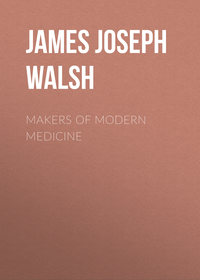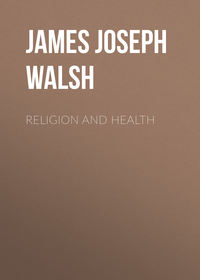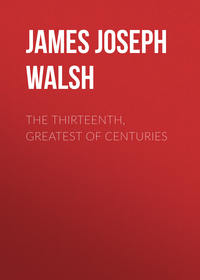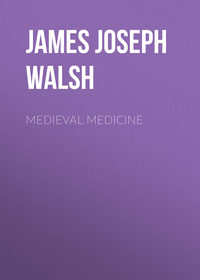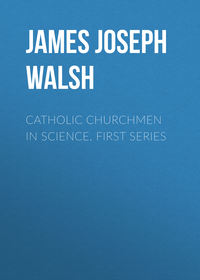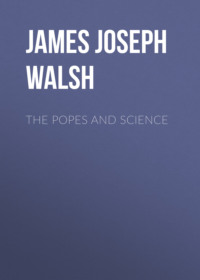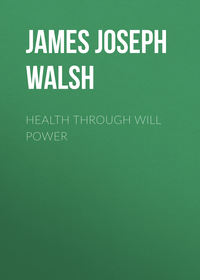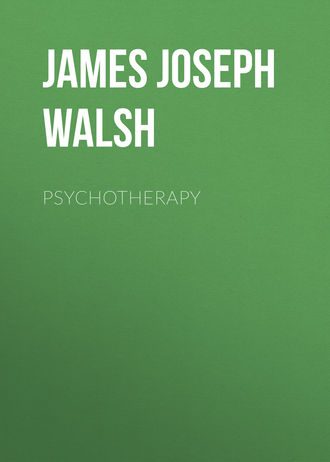 полная версия
полная версияPsychotherapy
The efficient ingredient in the sarsaparilla, so far as any of its various preparations have seemed to do good, has not been anything that was in the bottle, but the printer's ink that was absorbed from the outside of it. People were persuaded that they would get better, and, as far as most of them were concerned, this was of itself quite sufficient to turn the scale in favor of improvement that led to the obliteration of symptoms. So long as these symptoms were a source of worry and trouble to them, they continued to be quite incurable. Just as soon as the inhibition of nervous energy, due to worry and over-attention to their sensations, stopped, then the natural force of the body was sufficient to remove the sources of complaint.
Psychology, Old and New, of Remedies.—Men have always known how to take advantage of the possibility of influencing patients' minds by wondrous claims for remedies. Anyone is sadly deceived who thinks that it is only in recent times that men have learned to make their advertisements of nostrums suggestive by the promises made or that we have developed the psychology of advertising to such a degree as to appeal to the ailing more forcibly and surely than was done in the past. Here is the announcement that went with a remedy in old Irish medicine more than 1,000 years ago. It was, according to its inventor, "a preservative from death, a restorative for the want of sinews (strength), for the tongue-tied, a cure for swelling in the head, and of wounds from iron and of burning by fire, and of the bite of the hound; it preventeth the lassitude of old age, cures the decline, the rupture of the blood vessels, takes away the virulence of the festering sore, the fever of the blood, the poignancy of grief—he to whom it shall be applied shall be made whole." The announcement ended up with the panegyric "extolled be the elixir of life bequeathed by Diancecht to his people; by which everything to which it is applied is made whole." When it is noted that, besides death and loss of muscle power and aphasia and wounds and burns and bites, it also cures old age and consumption (for that is what is meant by decline) and hemorrhages, and probably aneurysms, and fevers and also grief, there are not many modern panaceas that exceed it in power.
Always, as in this Irish announcement of the olden time, the climax of the advertisement is a note of exultant praise for the inventor who has brought such a magnificent blessing to mankind. The ways of the nostrum vender are ever the same.
Roman Nostrums.—How old are all these methods, and how little human nature has changed through all the centuries! The patent medicine men of Rome in the early Christian eras made use of just the same methods that are employed to-day. Friedländer, in his "Roman Life and Manners Under the Early Roman Empire," tells the story well. Many remedies were known by special arbitrary names, instead of descriptive names recalling the ingredients. Sometimes they were named after famous physicians who had used them, or were said to have done so; again, the preparations were named after persons of distinction who actually, or supposedly, were cured thereby, much as, in our own day, cigars are named after poets, statesmen and pugilists. The titles of some of these preparations, for instance, were "Ointment for Gout, Made for Patroculus, Imperial Freedman—Safe Cure"; "Ointment for Aburnius Valens" (probably the famous jurist) called the "Expensive Ointment"; "Eye Salve with Which Florus Cured Antonia, the Wife of Drusus (the Emperor's son) After the Other Doctors had Nearly Blinded Her." Many of these remedies were labeled "instantaneous," "safe," "sure cure," "Harmless remedy," and the like. Frequently euphonious names, sometimes from the Greek, were chosen: Ambrosia, Anicetum, Nectarium, for the promoters evidently knew the satisfying effect, on both patient and physician, of a mystifying foreign name.
Proprietary Remedies .—A corresponding abuse very like that of our own time was with reference to proprietary medicines. Physicians, instead of compounding their own, accepted those made by others with the exaggerated claims for them, used them on patients, transferring their own confidence in them to the patients, thus producing cures which, after a time, proved to be due entirely to the influence on the patient's mind. Pliny, the elder, complains that physicians of his time (the first century after Christ) often bought their remedies so as to avoid the trouble of preparation. He evidently refers to compounds supposed to be curative for various affections; for Friedländer says that "often the physicians did not know the exact ingredients of the compounds that they used and should they desire to make up written prescriptions, would be cheated by the salesmen." Both Galen and Pliny complain that physicians used ready-made medicines, instead of original prescriptions carefully prepared by or under the supervision of the physicians themselves. It is evident that the proprietary remedy had come into existence thus early, and that various drug manufacturers made specialties which physicians, following the line of least resistance, found it easy to prescribe, though men like Pliny and Galen realized that this was an abdication of one of the most important functions of their profession, which was bound to work harm in the end both to themselves and to their patients.
How curious it is to find exactly the same state of affairs recurring in our time, with absolutely similar results. Simple remedies that are well known combinations of ordinary drugs receive high-sounding names, usually derivatives from the Greek or the like, and are claimed to work just as many wonders as the old-fashioned nostrums. Even imitations of the old-fashioned poultices, when thus exploited, give a new lease of life to the exploded idea of the drawing-out power of external applications.
Common Ailments and Nostrums.—Certain ailments are particularly the subject of exploitation by the manufacturers of remedies. Rheumatism is one of these, neuralgia is another, catarrh is a third, and headache a fourth. Then there are various forms of indigestion and all the pains and aches associated with it. All of these ailments are rather vague and are in some cases at least, due to the insistent dwelling of the patient's mind on some symptom of very little significance. Others are real pains and aches, relieved by some simple anodyne drugs, doubly efficient when taken with the suggestion that they represent a wonderful discovery, which came only after long years of study and investigation, and are said to represent a new departure in medicine. Another favorite field for the nostrum vender is the series of pains and aches associated with the menstrual condition. Many of these nostrums are used by hundreds of thousands, and yet an analysis shows that probably the only active substance in them is the alcohol in which certain of the drug principles are dissolved. This makes the patient feel better by the exaltation that comes from the dose of alcohol and the rest is merely suggestion, though there is no doubt that symptoms which have failed to be cured by physicians are sometimes relieved by these remedies. It is a cure by faith, not by medicine.
Cured Cases as Evidence.—As all of the nostrums, and indeed all the therapeutic movements supposedly medical or physical or religious, secure their vogue on the strength of reported cures, this would seem to be the best possible evidence for the efficacy of a remedy. But unless the cases supposed to be cured are critically examined and analyzed, and above all, followed for some time afterwards, such evidence is open to all sorts of errors. Is it any wonder, then, that the physician, familiar with the history of medicine in this regard, asks for the careful study and analysis of these cases. We know that it was on the strength of cures effected by it, that the weapon ointment became possible throughout Europe. We know that portions of the body of executed criminals and the touch of the hanged cured as many cases as, let us say, osteopathy or Eddyism. The sympathetic powder and its advocates appealed to the many cures that followed its use. Every other nostrum from the beginning of time has made this same appeal.
CHAPTER VIII
AMULETS, TALISMANS, CHARMS
Amulets, talismans, charms—these words are commonly used with something of the same significance, and for our purpose all three may be treated in common.
Prophylactic Objects.—From the earliest ages men have worn amulets, that is, objects often resembling jewelry, though sometimes the remains of animals or even of men,9 with the idea that they would ward off illness, or cure it when present. Rings of many sorts, brooches, various objects suspended around the neck, ear-rings, head-bands, belts for the waist, and rings for the wrists and the ankles, ornamented bracelets and anklets, have at all times had a medicinal power attached to them in some minds. Earrings are still worn by many with the idea that they are helpful in affections of the eyes. I have known children's ears to be pierced and earrings inserted because the little ones were suffering from headache. Precious stones were supposed to have this power when worn. The amethyst protected its wearer from drunkenness; the bloodstone cured anemia; while the opal was supposed to portend evil. Occasionally such gems were ground up and used as internal or external remedies, because of the power supposed to be attached to them. Their influence upon the mind, at least, can be readily understood. The earliest prescription we have in America is at the Metropolitan Museum, New York, among the curiosities from Egypt (about 1500 B.C.). It calls for the use of ground up precious stones in fumigations, probably for an hysterical person.
The precious metals were used also as powerful cures. Chaucer says, "for gold in physick is a cordial." Some think that our own use of chloride of gold a few years ago for many chronic ills had little more reason than the preciousness of gold impressing itself on patients. Inscriptions were made on the metals, and these were supposed to add to their healing or preservative quality. Famous among these was the abracadabra. It had to be written in a particular triangular form, and was then very powerful. Here the amulet invades the sphere of the charm. Prayers were written on parchment, or on paper, or on papyrus, in the old time in Egypt, Babylon and Assyria, and when worn about the body were supposed to do great good. It is surprising to us now how many physicians and scientists placed confidence in these things because they thought that they had seen good results. Alexander of Tralles recommends a number of them. Robert Boyle, the father of chemistry, says that he was cured of a severe ague, that the doctors could not benefit, by the application of an amulet to his wrists. Burton, in the "Anatomy of Melancholy," has a series of references that show how much he, himself, and the educated men of his time, believed in the power of amulets to help in illnesses and Boyle, particularly, has a number of references to precious stones and their curative virtue.
Rings in Therapy.—Under Faith Cures I mention the cramp rings blest by the Queen of England and effective against abdominal pains. Other kinds of therapeutic rings were used rather commonly. All through the Middle Ages iron rings were worn, which were good for colic and biliousness and also for rheumatic pains. There are literally thousands of such rings worn now, here in the United States, and by quite intelligent people. Personally, I know of more than a dozen cases where they have been worn for years. The wearers faithfully take them off each day, rub off the rust which collects on the inside, call their own and others' attention to the fact that all this material has been drawn out of the body through the supposed electrical power of the ring, and then they replace them. Here is pseudo science obtruding itself. Usually these rings are of polished steel and look a little like silver. They may, however, be obtained in gold plate, and then are supposed to be quite as efficacious. The iron or steel rings cost two dollars each; gold-plated rings cost five to ten dollars, according to the ability of the patient to pay, for metallotherapy has as one of its effects the lessening of congestion of the purse. Those who wear them would not part with them, because they feel the benefits derived. These rings are supposed to be particularly good for vague, painful conditions in the joints, especially the so-called rheumatic pains.
In old times these rings were sometimes engraved with a legend that was itself a strong suggestive element. The rings of the Middle Ages that were supposed to be a cure for biliousness were engraved with a command to the bile to go and take possession of a bird. Occasionally rings were supposed to be valuable because of their origin. Epileptic fits, for instance, were rendered much less frequent and less severe if a ring made of money that had been given in the church were worn. The condition was that the sufferer should stand at the church door asking a penny from every unmarried man who passed in or out. After sufficient alms had been thus collected the money was exchanged for silver money that had been contributed to the church, and from this the ring was made. It was to have a cross and sometimes a verselet from Scripture, or an exorcism, or a prayer, engraved on it. It is easy to understand that all of this represents strong suggestive influence and that the standing at the church door begging alms might well represent an enforced prolonged opportunity to get rest and air, for many unmarried men do not go to church, and so there were also physical factors at work in the cure noted.
Precious Stones as Preservatives.—Pettigrew, in his "Superstitions Connected with Medicine and Surgery," mentions a number of the precious stones and their power to heal. Garnet hung about the neck relieves sorrow and refreshes the heart; chrysolite is the wisdom stone, the enemy of folly; heliotrope staunches blood and acts as an antidote; sapphire is good for ague and gout, and also gives its wearer courage; it also stops bleeding at the nose and was an antidote; the topaz was good for lunatics; the carnelian cured bloody fluxes and also fluxes of anger and passion. Jasper, hematite and similar stones had certain general powers of doing good. The Bezoar stone had a great reputation against melancholy; the smaragdum was infallible against epilepsy; the onyx was good for sleep; the sardonyx prevented bad dreams. The most wonderful stone, however, was the agate; taken in liquid it was good for any disease. It made the skin healthy. It preserved against snakebite, and against all poisons, and it prevented the devil from injuring one who wore it or drank it, and also preserved him from being struck by lightning. Considering how common agates were and how readily they could be obtained, it is rather surprising that we should have so many stories of illness and deaths by lightning and from poison and from venomous serpents in the old days when its curative value was rated so high.
Amulets.—The coin given by the kings of England when they healed the scrofulus or epileptic came to be, in one sense, an amulet. The sight and the touch of this acted as an ever recurrent suggestion tending to make these patients better, and undoubtedly the coin was of great service by its renewal of the mental influence of the touch of the king. There are traditions, also, that these coins healed others who touched them, and sometimes for generations they were kept in families as representing a fountain of healing and of preservation of health. Any object that thus became invested with reverence produced healing effects. Virchow, in the introduction to Schliemann's "Troas," tells of going to a long distance for water, during the time when he was present at the excavations, in order to be sure that the water would be absolutely pure. The natives had heard that he was a great physician from the West. They concluded that the reason why he went to this particular distant spring for water, in spite of the trouble involved, was that it must have some wonderful healing virtues. Accordingly a tradition of healing grew up around it, and people came from long distances, drank from it and were cured.
There are still people who carry horse chestnuts for rheumatism, and occasionally a farmer carries a potato for the same purpose. The feeling is, if they do no good, at least they can do no harm. Doubtless in the Middle Ages the same feeling prevailed as to other favorite objects. At present, among the better informed classes, various pendants supposed to have some connection with electricity are popular. I have seen a medal made of alternate discs of copper and zinc, and confidently believed to be strongly electrical, worn even by an otherwise sensible merchant in a country town. Electric belts still are extremely common—and expensive. Supposed electric insoles, one made of copper, the other of zinc, are sold in great numbers and at good prices, though, quite needless to say, they are absolutely inert electrically. Various electric contrivances, small batteries, and the like, really are of the nature of amulets. People have a faith in them that is not justified by anything in science, but that faith helps them in their ills. Most of the supposed medicinal plasters are in the same class. As a rule, sufficient curative material cannot be incorporated in a plaster to be of any service, and most of them, though widely advertised, are scarcely more than rubber adhesive plaster. They do good partly by their mechanical effect, because they actually support muscles, but mainly because of faith in their efficacy. Whenever a particular discomfort occurs the feeling that a plaster is covering the spot gives the patient assurance that he or she must soon be better. In all of these effects there is no manifestation of any physical or marvelous supernormal power, but simply and solely of the influence of the mind on the body.
CHAPTER IX
DETERRENT THERAPEUTICS
In the history of therapy a peculiar phase was the use of all sorts of materials, intensely repugnant to human nature and deterrent to all the finer feelings, but which, nevertheless, proved curative of many ills. We know now that there was absolutely nothing remedial in these substances or methods of treatment, but only the effect produced upon the patient's mind. If the patient makes sufficient effort to overcome the intense repugnance, that enables him to release hitherto latent vital energies, or to correct hampering inhibitions which have prevented curative reactions. The more the patient had to conquer himself, or herself, the more surely did the remedy produce a good effect. It was effective, however, not only among the poor and the uneducated, but often also among the better informed, provided the patients became persuaded of its efficiency. Persuasion in these matters is usually best secured by the reports of cured cases. It is easy to obtain "cures" from almost anything. They are set up as confident proofs of the remedial virtue of methods of treatment. They have been, in the history of medicine, more often the indexes of action upon mind than upon body. Real remedies help patients to get better. Supposed remedies, that afterwards prove quite inert, cure.
Portions of Corpses.—One of the ingredients of the famous Unguentum Armarium (see chapter on Nostrums) was, as has been said, moss scraped from the skull of a man who had been hanged. It was declared to be particularly efficacious against so-called dead members, such as the blanched fingers of Raynaud's disease, or the hysterical palsies, and other functional paralytic conditions of the limbs. The real therapeutic factor was not the gruesome material itself, but the potent suggestions awakened by it. It is probable that the quacks and witch doctors who gave out the formula of their remedies as containing such material often did not take the trouble to collect them, and that their salves and ointments were really quite inoffensive preparations.
Touch of the Hanged.—Some of the traditions which gather round the effect of contact with the body of a hanged person are curiously interesting from the standpoint of psychotherapy. This form of execution seems to have had a much more potent influence in producing therapeutic elements in the bodies of the victims than any other. We do not hear much of the touch of a beheaded person's body nor of any place in medicine for portions of the victims of execution by shooting, though Van Helmont claims curative properties for these in lesser degree. All sorts of ailments were, however, supposed to be cured by the touch of a hanged person. Thomas Hardy in his "Wessex Tales" tells of a young woman in his time suffering from a paralyzed arm, apparently a form of paralysis due to a functional nervous condition, who was recommended by an old "conjure" doctor to touch her bared arm, as soon after the execution as possible, to the purple mark of the rope around the neck of a man who had been hanged. The doctor assured her this was the only means by which she could be cured. We would not be surprised to hear of her cure under such circumstances.
Hardy has carefully collected his material regarding the traditions of the southern part of England, and he makes the hangman say, when the woman applies to him for permission to touch the body of the victim, that such a request had not been made for some years, but that there used to be many applicants when he was a younger man. He adds, moreover, that it was the custom to apply to the governor of the prison and that usually this application was made by the physician of the patient who accompanied him or her on the visit to the corpse. There is no doubt that physicians did, in many cases, have recourse to such methods, and that the reasons for their belief in the efficacy of the touch of the dead was that they had seen the cure in this way of many puzzling diseased conditions, which their skill in wortcraft and herbal medicines had not enabled them to relieve. The touch of the corpse was supposed to bring about a "turning of the blood," and this produced the good effects. Occasionally the patients fainted from terror, yet afterwards were found to be able to use limbs that had been quite beyond their control before. The story is typical of what happened in country districts all over Europe for centuries.
Mummies.—How little distant we are from the use of such material for therapeutic purposes will be appreciated from the fact that mummy was used in medicine down nearly to the end of the eighteenth century. The first edition of the "Encyclopedia Brittanica" (1768) said:
We have two different substances preserved for medicinal use under the name of mummy, though both in some degree of the same origin. The one is the dried and preserved flesh of human bodies, embalmed with myrrh and spices; the other is the liquor running from such mummies, when newly prepared, or when affected by great heat or damps. The latter is sometimes in a liquid, sometimes of a solid form, as it is preserved in vials well stopped, or suffered to dry and harden in the air. The first kind of mummy is brought to us in large pieces, of a lax and friable texture, light and spongy, of a blackish brown color, and often damp and clammy on the surface: it is of a strong but disagreeable smell. The second kind of mummy, in its liquid state, is a thick, opaque, and viscous fluid, of a blackish color, but not disagreeable smell. In its indurated state, it is a dry solid substance, of a fine shining black color, and close texture, easily broken, and of a good smell; very inflammable, and yielding a scent of myrrh and aromatic ingredients while burning. This, if we cannot be content without medicines from our own bodies, ought to be the mummy used in the shops; but it is very scarce and dear; while the other is so cheap, that it will always be most in use.
All these kinds of mummy are brought from Egypt. But we are not to imagine, that anybody breaks up the real Egyptian mummies, to sell them in pieces to the druggists, as they may make a much better market of them in Europe whole, when they can contrive to get them. What our druggists are supplied with, is the flesh of executed criminals, or of any other bodies the Jews can get, who fill them with the common bitumen so plentiful in that part of the world; and adding a little aloes, and two or three other cheap ingredients, send them to be baked in an oven, till the juices are exhaled, and the embalming matter has penetrated so thoroughly that the flesh will keep and bear transportation into Europe. Mummy has been esteemed resolvent and balsamic: but whatever virtues have been attributed to it, seem to be such as depend more upon the ingredients used in preparing the flesh, than in the flesh itself; and it would surely be better to give those ingredients without so shocking an addition.




